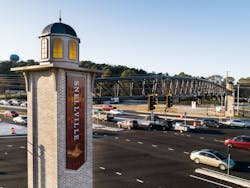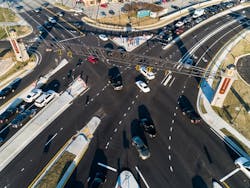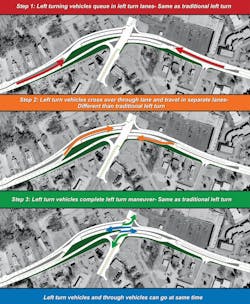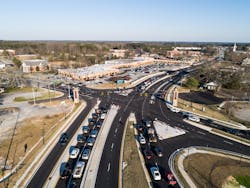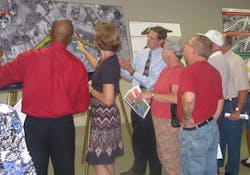A fresh design idea relieves congestion and reduces conflict points on a Georgia intersection
Located between Atlanta and Athens in Georgia, Snellville has become one of Gwinnett County's fastest-growing cities, boasting family-friendly parks, historic resources, festivals, and community events.
Unfortunately, the existing intersection of U.S. 78/S.R. 10 (Main Street) at S.R. 124 (Scenic Highway), which sat at the heart of Snellville, was not something to boast about. Extreme traffic conditions—including major delays during peak traffic hours—had prompted numerous studies over almost 20 years, resulting in options for improvements that only angered and frustrated local citizens because of their propensity to change the landscape of their beloved community.
The Georgia DOT (GDOT) ultimately charged Gresham Smith’s engineers with developing a viable design solution for this problematic intersection where others had failed. A solution that residents, elected officials, and business owners alike could all finally rally around.
TWO LEGS ARE BETTER THAN THREE
Various alternatives for the existing intersection were explored, from outer bypasses to local bypasses, and even a grade separation at U.S. 78 and S.R. 124. All of these recommendations, however, were costly and lacked community consensus. A grade separation, for example, would have separated the city into two sections, if not three or four, in a fairly pedestrian- and bicycle-unfriendly environment, further driving multimodal safety concerns. Moreover, it would have been an aesthetically displeasing and costly alternative that made it all but impossible to preserve the surrounding environment and the town’s historic resources. The interplay between the new City Hall area and some of Snellville’s redeveloped areas would have also been disturbed by a grade separation.
Armed with the knowledge of what did not work, and perhaps most importantly, why, Gresham Smith explored numerous design alternatives, including a three-legged continuous flow intersection (CFI) that would impact three of the four legs. After reviewing a traffic analysis of the entire downtown Snellville area, and garnering input from a Citizen’s Advisory Committee (CAC) made up of vested property owners, project planners zeroed in on a preferred alternative that was a pioneering idea for its time—a two-legged continuous displaced left turn (DLT) intersection.
COMMUNITY BUY-IN
When engineers began designing the DLT in 2007, it was the first of its kind for Georgia, with no precedents whatsoever for the design of this type of project. Consequently, planners were challenged with gaining all-important public consensus, which is why the Citizens Advisory Committee was so pivotal to the success of the project. Although it consisted of a small group of citizens within the Snellville community, they represented a passionate community at large when it came to implementing a context-sensitive solution.
As part of the CAC process led by Gresham Smith, the concerns of the representative group of stakeholders, many of them spurred by the drawbacks of the previous alternatives, were paramount. Working with the CAC, planners developed numerous new alternatives, listing the advantages and disadvantages of each option. This allowed the team to build consensus and understand why the DLT was the best alternative. By demonstrating how the DLT would improve mobility and safety for all modes of traffic, and with far less impact to surrounding properties, project designers ultimately gained buy-in from the CAC, who then served as champions for the project at a public information open house, where they educated other members of the public about the benefits of this anything-but-typical intersection configuration.
A separate educational public information open house was also held closer to opening to traffic, in which project representatives educated motorists on how to navigate the new DLT. The team worked closely with GDOT to develop numerous educational materials, including a simulation video, displays on the new lane configurations, traffic signals, vehicle movements, and turn prohibitions.
TARGETING LEFT TURNS AT THE CROSSROADS
After years of design work and months of construction, the project opened to traffic in stages, beginning in the spring of 2019. The project as a whole comprises improvements made to Henry Clower Boulevard, displaced left turns from U.S. 78 in Snellville to S.R. 124, and a new southbound right-turn lane from S.R. 124 to U.S. 78. Improvements to Henry Clower Boulevard were designed so that the road can serve as a bypass thoroughfare to relieve pressure and improve operations at the busy intersection of U.S. 78 and S.R. 124.
The DLT configuration creates unopposed left turns at the intersection by crossing traffic over to the other side of the road before the main intersection in a median-separated left-turn lane. At the intersection, left-turning and through-traffic move simultaneously as directed by coordinated traffic signals.
It is important to note that the project actually includes two DLTs with dual left-turn lanes—one for drivers traveling eastbound on U.S. 78 and turning left on S.R. 124 toward Lawrenceville, and one for motorists driving westbound on U.S. 78 and turning left on S.R. 124 toward I-20.
Collectively, the improvements increase the number of vehicles that can move through the intersection and help it operate more efficiently. The DLT configuration reduces the total number and overall severity of vehicle-to-vehicle conflict points, with conflict points decreasing from 32 to 28 when compared to a conventional signalized intersection.
HOW THE DLT WORKS: A DEEPER DIVE
When traveling east or west along U.S. 78, in order to turn left on S.R. 124, drivers line up at the left-turn lane, as with a conventional intersection, only a little farther back. When the traffic signal turns green, drivers cross over the lanes for opposing traffic into two new lanes on the left side of the road and proceed to S.R. 124. A median separates the new left-turn lanes from traffic moving in the other direction. At S.R. 124, there is another traffic signal. When the left-turn arrow is green, drivers turn left on S.R. 124. The traffic signals at the crossover and main intersection are coordinated to minimize multiple stops.
When traveling northbound on S.R. 124, motorists who wish to turn right on U.S. 78 toward Loganville, or left on U.S. 78 toward Stone Mountain, can turn right or left on Henry Clower Boulevard to access U.S. 78. No right or left turns are permitted onto U.S. 78 from S.R. 124.
Traveling southbound on S.R. 124 toward I-20 works similarly. Motorists who wish to turn right enter the dedicated right-turn lane, stop at the signal as required for pedestrians, and then proceed onto westbound U.S. 78. Southbound through-movements and left turns are not significantly different as a result of the DLT.
The full project, including the displaced left turns on westbound U.S. 78, was completed at the end of 2019. Kimberly J. Kimbrough, project manager at GDOT, had this to say about the project:
“As the second DLT designed in an urban area in the state of Georgia, the project represents a significant achievement for GDOT. The proactive effort to engage with key stakeholders and the local community was absolutely integral to the success of the project. The end result is a unique design solution that met the operational needs of this critical intersection, while minimizing impacts to the surrounding land uses.”
SETTING ADDITIONAL PRECEDENTS
Another unique aspect to the intersection is that it included the installation of Georgia’s first and only signal truss bridge, which comprises a 191-ft-long, single-span arch truss. Because the intersection is located in the heart of downtown Snellville, the bridge had to function efficiently for traffic operations, while also serving as an iconic gateway to the city of Snellville. Gresham Smith engineers coordinated with the selected Georgia-based general contractor, Pittman Construction, on the DLT, as well as the arch truss signal bridge.
“The signal truss bridge was such a unique part of the DLT project because nothing like it had ever been executed in the state of Georgia,” said Jim Bronaugh, vice president and chief engineer at Pittman, describing the night the bridge was erected. “It was an amazing experience to see the bridge being set up on the columns and then watch the pieces fit together just like they were supposed to—the very first time. The city of Snellville now has a marquee structure that effectively accommodates the signal infrastructure, while at the same time evoking a sense of pride in the local community.”
Bronaugh also weighed in on the DLT:
“Because we made some major traffic switches to the intersection overnight, motorists—many of them locals—woke up to a brand-new configuration the next day. This meant that instead of going straight, they had to veer to the left to get into the new lanes that they had not previously driven. For this reason, the simulation video and other materials shared at the educational public information open house were so important in leading up to the lane changes. It was also critical that our temporary signage was highly visible to motorists—especially to the older demographic, who could have potentially been driving on the intersection for decades, and been more than just a little used to the existing conditions.”
Pittman Construction used a polymer-modified asphalt, or liquid asphalt, for the riding surface, which provides greater durability than a standard asphalt surface, particularly at the intersection where there are heavy turning movements and stop-and-go traffic. As a result, residents should be able to enjoy the results of the project for years to come.
MAINTAINING THE HEART OF THE CITY
Only the second DLT to be constructed in the state of Georgia, the intersection at U.S. 78/S.R. 10 and S.R. 124 now serves as a case study for future projects of its type, demonstrating how safety, mobility, and congestion can be augmented through unopposed left turns and simpler traffic signal phases. Prior to the project, the major traffic delays were significantly impacting Snellville’s economic development. The DLT solution was successful in maintaining the core of the town’s city center, alleviating the concerns of the local community, and preserving the area’s vital historic, social, and natural environments.
